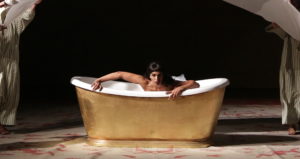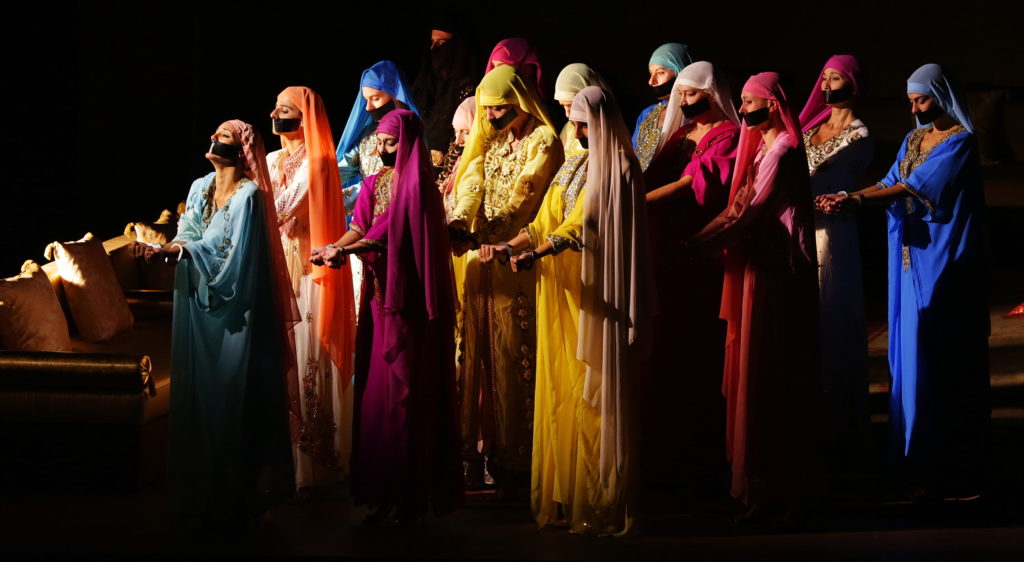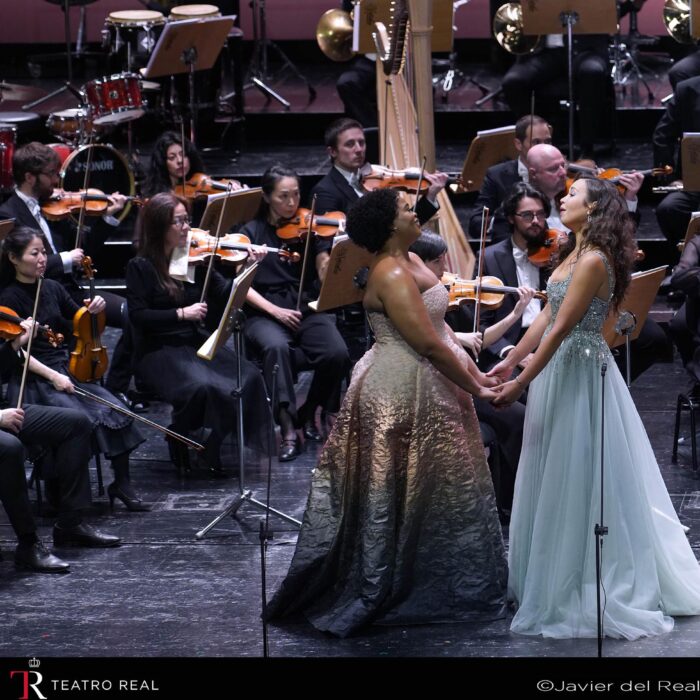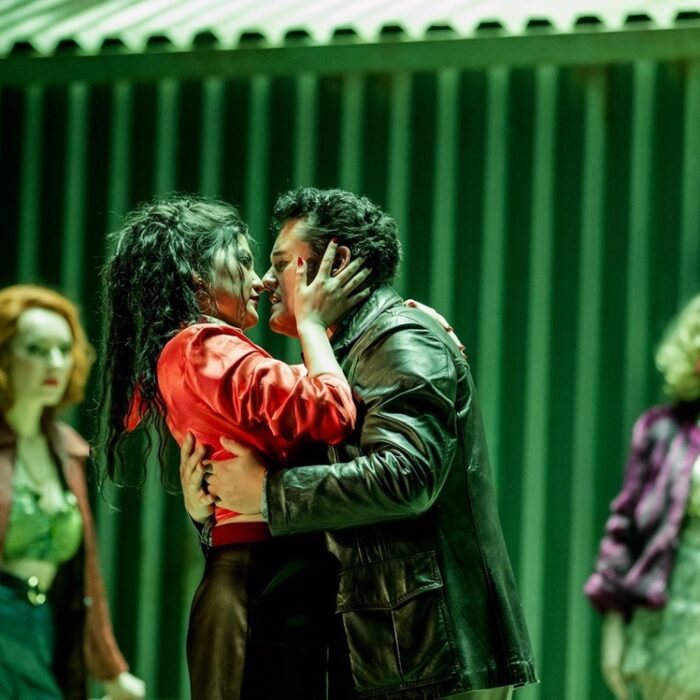
Teatro alla Scala 2019-20 Review: Giulio Cesare in Egitto
Danielle De Niese, Christophe Dumaux, Philippe Jaroussky Shine In Robert Carsen’s Unique Vision
By Ching Chang(Credit: Brescia/Amisano – Teatro alla Scala)
It is surprising that G.F. Handel’s “Giulio Cesare in Egitto” has had only one previous outing (back in 1956) at Milan’s Teatro alla Scala, as it is perhaps a work rich in veins of Italian national pride: a heroic tale based upon the valor and moral fortitude of one of Rome’s most glorious emperors, told through beautiful music conveying the composer’s homage and self-evident love for the ageless Italian lyrical style, and for the work of a German composer based in London, exalts the deep influence of Italian music upon the world.
Yet, the impending premiere of Canadian director Robert Carsen’s inventive new production, specifically created for La Scala, met some serious threat of cancelation (or at least postponement), challenged in some unexpected ways.
Unions & A Diva Nearly Derail Handel
First, Italian diva Cecilia Bartoli, the production’s marquee star assigned to the role of Cleopatra, withdrew on short notice just as ticket sales had opened to the public, outing her dissent in support of La Scala’s superintendent Alexander Pereira, whose expiring contract at the venerable institution was not renewed by the board.
Some ticket buyers complained bitterly that for a while, Bartoli’s name was still listed for the production in the theater’s website, even when it was already known that she wouldn’t be appearing.
Then, just as the theater’s administration was successful in securing a new Cleopatra in the Danielle de Niese, La Scala’s unions approved by vote a call to go on strike on Oct. 18 (the day of the production’s opening), protesting the inadequate per diems its workers received while on foreign tours. Fortuitously, it was called off after an intervention by Milan’s Mayor Giuseppe Sala, who promised to appeal on behalf of the workers demands with the Italian Minister of Culture Dario Franceschini.
With these challenges overcome, Carsen’s brilliant, updated modern production was unveiled with a stellar international cast, elegantly supported by La Scala’s baroque ensemble led capably by Maestro Giovanni Antonini, the founder and artistic director of Italy’s esteemed period ensemble Il Giardino Armonico and a respected Handelian interpreter.
A Unique Vision
Maintaining the plot framed within its layers of civil unrest affecting both the Roman’s and Egyptian’s camps, Carsen places the action in a non-descript modern middle eastern setting, with themes suggesting possibly the Italian colonial ambitions of the early 20th century. The production’s poster, a lone soldier pointing a menacing machine gun in a desolate desert landscape, suggested perhaps that the Canadian director was going to pursue a militaristic and austere staging. It was indeed so at times, but Carsen found a near perfect balance between the opera seria gravitas of combat tragedy, and the subtle, well timed satirical references, never allowing it to degrade into the farce of a Regietheater cliché.
For instance, Cesare’s “Va tacito e nascosto,” the hunting aria with the buoyant horn obbligato sung with aplomb by countertenor Bejun Mehta, was set as a stylized ritual of a diplomatic gift exchange, with the Romans offering of FENDI luxury branded gift bags stuffed with fine tailored Italian suits and soccer balls — suggesting the Roman’s vision for cultural dominance in a foreign land — while the Egyptians just offered Roman occupiers the ever practical desert gifts of light linen tunics and watermelons. Also, Carsen set the scene in Lydia’s temple rather as a private movie session for Cesare’s night off, featuring a string of classic golden age Hollywood silverscreen actresses’ (Claudette Cobert, Vivien Leigh and Elizabeth Taylor) portrayals of Cleopatra, leading up to the appearance of de Niese’s Cleopatra disguised as the muse Lydia, singing the intoxicating “V’adoro pupile.”
In contrast, one of the darkest and most gripping scenes of the evening was the setting of “Domerò la tua fierezza,” Tolomeo’s uncomfortably real humiliation scene of his sister Cleopatra, with whom he had engaged in open hostitliy. Treating her as a prisoner of war, Tolomeo tortures her with lit cigarettes, and points a handgun to her various body parts, as Christophe Dumaux sailed imperiously through the aria’s fierce bravura vocal lines. This was soon followed by de Niese’s Cleopatra’s desolate singing of the great “Piangerò la sorte mia,” in deeply felt anguish as she embraced her fallen resistance soldiers, strewn lifeless on stage, masterfully contrasted with the bravura rage of “Ma poi morta,” the aria’s middle section swearing revenge.
Gideon Davey’s sets were weightless and efficient in their economy, and perhaps achieve their greatest effectiveness at their most elemental simplicity, such as in the gorgeously rendered duet by Cornelia and Sesto, “Son nata a lagrimar,” with house favorite mezzo Sara Mingardo and countertenor Philippe Jaroussky (making his La Scala debut) placed separately on a darkened empty stage, each singer lit only by a confined square space. Davey’s sets complemented well the excellent, vigorous and articulate choreography by Rebecca Howell, informed by martial and combat rituals.
If there was an inevitable lesson to be had in Carsen’s take, it came near the end of this four-hour long opera, to shake us from our various lofty assumptions. With the tyrannical Tolomeo finally destroyed, Cleopatra (fresh from her bathing scene in the triumphal “Da tempeste in legno infranto”) has an onstage costume change, revealing the Egyptian queen now in a boardroom ready business suit, as she and Cesare manifest their true mutual interests by signing dozens of agreements and treatises, just as the backdrop lifts to reveal a massive oil pipeline across the desert landscape being turned on.
Soon, as the chorus sings in victorious praise, dozens of large red oil barrels are rolled on stage, each painted with a branding depicting a fire-breathing camel — an insider’s jocular reference to “Agip”, the Azienda Generale Italian national oil company, whose icon is a fire-breathing horse.

(Credit: Brescia/Amisano – Teatro alla Scala)
In Synch
It turns out that perhaps these performances were helped by the withdrawal of Bartoli, for a star of her caliber would have inevitably skewed the balance of the performance towards that of a diva vehicle, and not the truly delicious ensemble work it became. Both countertenor Bejun Mehta and soprano Danielle de Niese showed great individual strengths and presence, delivering their assignments respectably like true veterans. They did not however always achieve vocal splendor: Mehta lacked at times the necessary authority to convey the moral impetus of the plot, and soprano de Niese flirted dangerously with shouting as Cleopatra’s lines ascended towards climactic top notes.
What truly elevated this performance was the quality of the supporting cast, equal or superior to the leading principals in every respect.
Philippe Jaroussky’s Sesto showed enormous range, delivering “Svegliatevi nel core” with the youthful resolve not unlike that of a Tin Tin ready to start a new adventure. Later, his touching rendition of “Cara speme” was a jewel almost too precious.
Mezzo Sara Mingardo’s “Priva son d’ogni conforto” rightfully earned the first applause of the evening, rendered with understated sincerity and avoiding any hint of verismo melodrama.
Bass Christian Senn was vocally potent and articulate, splendid in the characterization of Achilla’s mercenary nature.
But by far, the most spectacular performance of the evening was by Christophe Dumaux as Tolomeo, with his every aria and scene elevating the menace and danger of this crucial character, one that has often been portrayed problematically in some productions. The French countertenor sang with satisfying, unerring potent tone, and showcasing jaw dropping, gorgeously phrased bravura work.
Maestro Giovanni Antonini led La Scala’s baroque ensemble with great finesse and elegant pace, allowing singers to breathe comfortably and without ever creating a rushed feeling. Though the performance lasted nearly four hours, Antonini managed to never allow it to feel tedious, or make one wish that a particular aria or da capo had been cut. It turns out a period ensemble does fine acoustically in the large 2000-seat Teatro alla Scala, with individual instruments sounding quite well with perfect definition.
The response of the packed house was warm and enthusiastic, and the notorious loggionisti either stayed home or displayed their best behavior for the evening. Since the founding of the theater’s baroque ensemble, this “Giulio Cesare” represents a current La Scala artistic initiative, with a plan underway to present one baroque opera per season, and it will continue in future seasons with Handel’s “Agrippina” and “Ariodante.”


